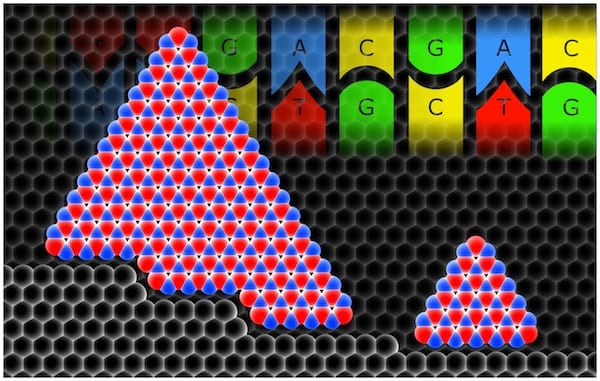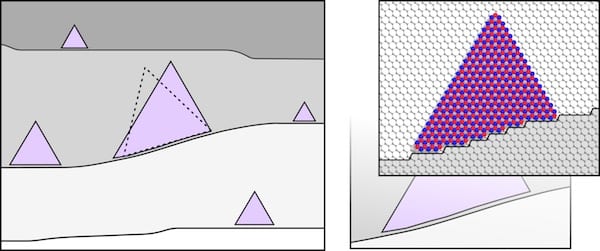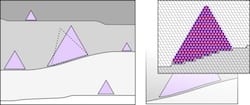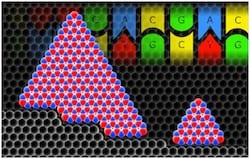NEWS RELEASE
Editor’s note: Links to high-resolution images for download appear at the end of this release.
David Ruth
713-348-6327
david@rice.edu
Mike Williams
713-348-6728
mikewilliams@rice.edu
Step right up for bigger 2D sheets
Rice University theory shows how monocrystals of hexagonal boron nitride come together
HOUSTON – (March 4, 2019) – Very small steps make a big difference to researchers who want to create large wafers of two-dimensional material.
Atom-sized steps in a substrate provide the means for 2D crystals growing in a chemical vapor furnace to come together in perfect rank. Scientists have recently observed this phenomenon, and now a Rice University group has an idea why it works.

Rice University researchers determined complementarity between growing hexagonal boron nitride crystals and a stepped substrate mimics the complementarity found in strands of DNA. The Rice theory supports experiments that have produced large, oriented wafers. Illustration by Ksenia Bets
Rice materials theorist Boris Yakobson and researcher Ksenia Bets led the construction of simulations that show atom-sized steps on a growth surface, or substrate, have the remarkable ability to keep monolayer crystal islands in alignment as they grow.
If the conditions are right, the islands join into a larger crystal without the grain boundaries so characteristic of 2D materials like graphene grown via chemical vapor deposition (CVD). That preserves their electronic perfection and characteristics, which differ depending on the material.
The Rice theory appears in the American Chemical Society journal Nano Letters.
The investigation focused on hexagonal boron nitride (h-BN), aka white graphene, a crystal often grown via CVD. Crystals nucleate at various places on a perfectly flat substrate material and not necessarily in alignment with each other.
However, recent experiments have demonstrated that growth on vicinal substrates – surfaces that appear flat but actually have sparse, atomically small steps – can align the crystals and help them merge into a single, uniform structure, as reported on arXiv. A co-author of that report and leader of the Korean team, Feng Ding, is an alumnus of the Yakobson lab and a current adjunct professor at Rice.

Rice University researchers, from left, Ksenia Bets, Boris Yakobson and Nitant Gupta, have simulated the growth of 2D monocrystals of hexagonal boron nitride and detailed the mechanism by which large crystals form on a stepped surface. Photo by Jeff Fitlow
But the experimentalists do not show how it works as, Yakobson said, the steps are known to meander and be somewhat misaligned.
“I like to compare the mechanism to a ‘digital filter,’ here offered by the discrete nature of atomic lattices,” he said. “The analog curve that, with its slopes, describes a meandering step is ‘sampled and digitized’ by the very grid of constituent atomic rows, breaking the curve into straight 1D-terrace segments. The slope doesn’t help, but it doesn’t hurt. Surprisingly, the match can be good; like a well-designed house on a hill, it stands straight.
“The theory is simple, though it took a lot of hard work to calculate and confirm the complementarity matching between the metal template and the h-BN, almost like for A-G-T-C pairs in strands of DNA,” Yakobson said.
It was unclear why the crystals merged into one so well until simulations by Bets, with the help of co-author and Rice graduate student Nitant Gupta, showed how h-BN “islands” remain aligned while nucleating along visibly curved steps.
“A vicinal surface has steps that are slightly misaligned within the flat area,” Bets said. “It has large terraces, but on occasion there will be one-atom-high steps. The trick by the experimentalists was to align these vicinal steps in one direction.”
In chemical vapor deposition, a hot gas of the atoms that will form the material are flowed into the chamber, where they settle on the substrate and nucleate crystals. h-BN atoms on a vicinal surface prefer to settle in the crook of the steps.
“They have this nice corner where the atoms will have more neighbors, which makes them happier,” Bets said. “They try to align to the steps and grow from there.
“But from a physics point of view, it’s impossible to have a perfect, atomically flat step,” she said. “Sooner or later, there will be small indentations, or kinks. We found that at the atomic scale, these kinks in the steps don’t prevent h-BN from aligning if their dimensions are complementary to the h-BN structure. In fact, they help to ensure co-orientation of the islands.”

Complementarity between the energies of atoms forming hexagonal boron nitride and a metal substrate lead to uniform wafers of 2D materials in a chemical vapor deposition furnace. The theoretical confirmation by Rice University scientists shows how growing crystals of the material use the steps in a vicinal substrate to stay oriented, which allows them to join into larger crystals. Illustration by Ksenia Bets
Because the steps the Rice lab modeled are 1.27 angstroms deep (an angstrom is one-billionth of a meter), the growing crystals have little trouble surmounting the boundary. “Those steps are smaller than the bond distance between the atoms,” Bets said. “If they were larger, like two angstroms or higher, it would be more of a natural barrier, so the parameters have to be adjusted carefully.”
Two growing islands that approach each other zip together seamlessly, according to the simulations. Similarly, cracks that appear along steps easily heal because the bonds between the atoms are strong enough to overcome the small distance.
Any path toward large-scale growth of 2D materials is worth pursuing for an army of applications, according to the researchers. 2D materials like conductive graphene, insulating h-BN and semiconducting transition metal dichalcogenides are all the focus of intense scrutiny by researchers around the world. The Rice researchers hope their theoretical models will point the way toward large crystals of many kinds.
Yakobson is the Karl F. Hasselmann Professor of Materials Science and NanoEngineering and a professor of chemistry at Rice.
The U.S. Department of Energy (DOE) supported the research. Computer resources were provided by the National Energy Research Scientific Computing Center, supported by the DOE Office of Science, and the National Science Foundation-supported DAVinCI cluster at Rice, administered by the Center for Research Computing and procured in partnership with Rice’s Ken Kennedy Institute for Information Technology.
-30-
Read the abstract at https://pubs.acs.org/doi/abs/10.1021/acs.nanolett.9b00136.
Follow Rice News and Media Relations via Twitter @RiceUNews.
Related materials:
Yakobson Research Group: https://biygroup.blogs.rice.edu
Rice Department of Materials Science and Nanoengineering: https://msne.rice.edu
George R. Brown School of Engineering: https://engineering.rice.edu
Images for download:
https://news2.rice.edu/files/2019/03/0304_MONOCRYSTAL-1-WEB-1f4i0qx.jpg
Rice University researchers, from left, Ksenia Bets, Boris Yakobson and Nitant Gupta, have simulated the growth of 2D monocrystals of hexagonal boron nitride and detailed the mechanism by which large crystals form on a stepped surface. (Credit: Jeff Fitlow/Rice University)
https://news2.rice.edu/files/2019/03/0304_MONOCRYSTAL-2-WEB-1gxg785.jpg
Complementarity between the energies of atoms forming hexagonal boron nitride and a metal substrate lead to uniform wafers of 2D materials in a chemical vapor deposition furnace. The theoretical confirmation by Rice University scientists shows how growing crystals of the material use the steps in a vicinal substrate to stay oriented, which allows them to join into larger crystals. (Credit: Ksenia Bets/Rice University)
https://news2.rice.edu/files/2019/03/0304_MONOCRYSTAL-3-WEB-1m6yl7e.jpg
Rice University researchers determined complementarity between growing hexagonal boron nitride crystals and a stepped substrate mimics the complementarity found in strands of DNA. The Rice theory supports experiments that have produced large, oriented wafers. (Credit: Ksenia Bets/Rice University)
Located on a 300-acre forested campus in Houston, Rice University is consistently ranked among the nation’s top 20 universities by U.S. News & World Report. Rice has highly respected schools of Architecture, Business, Continuing Studies, Engineering, Humanities, Music, Natural Sciences and Social Sciences and is home to the Baker Institute for Public Policy. With 3,962 undergraduates and 3,027 graduate students, Rice’s undergraduate student-to-faculty ratio is just under 6-to-1. Its residential college system builds close-knit communities and lifelong friendships, just one reason why Rice is ranked No. 1 for lots of race/class interaction and No. 2 for quality of life by the Princeton Review. Rice is also rated as a best value among private universities by Kiplinger’s Personal Finance.




